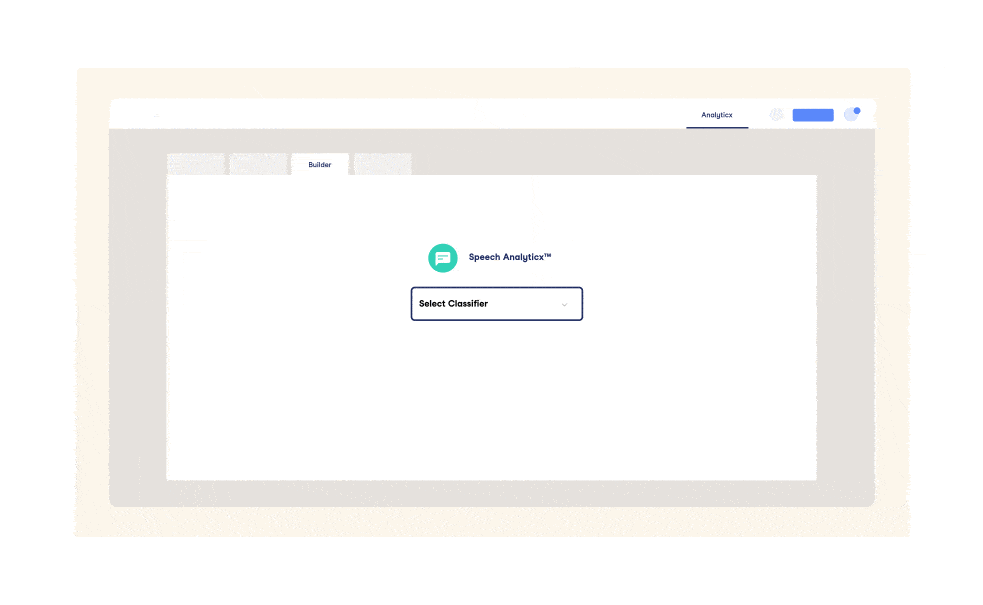
Find and listen to data that matters with Speech Analyticx™
Summarize themes and trends across all interactions with metrics around conversation topics, sentiment, and key reporting to tell the ‘big picture’ story.
Learn MoreAI is changing the way healthcare listens. Authenticx analyzes customer conversations to uncover actionable insights.
Engage with the story your customers are sharing.
Collecting data is only part of the equation. Understand the call drivers of your customers to discover how to resolve disruptions.
See Authenticx in Action
Sentiment Analysis AI
Sentiment analysis AI, a branch of natural language processing (NLP), is the automated process of determining the opinions and attitudes expressed in textual data. With the increasing volume of user-generated content on the internet, businesses are leveraging sentiment analysis machine learning techniques to gain valuable insights and improve decision-making.
At its core, sentiment analysis AI involves the use of machine learning algorithms to classify text data into different sentiment categories, such as positive, negative, or neutral. These algorithms are trained on large datasets containing labeled examples, which helps the model learn to identify and predict the sentiments associated with a given piece of text.
Sentiment analysis algorithm accuracy has improved significantly over the years thanks to advancements in NLP, deep learning, and computational resources. There are several types of sentiment analysis, each catering to specific needs and use cases. Some of the most common types include:
- Fine-grained sentiment analysis: This type of analysis categorizes sentiments into more nuanced categories, such as very positive, positive, neutral, negative, and very negative. It is particularly useful when businesses require a deeper understanding of customer sentiment.
- Aspect-based sentiment analysis: Instead of classifying the overall sentiment of a text, aspect-based analysis identifies the sentiment towards specific aspects or attributes of a product or service. This allows organizations to pinpoint areas that need improvement.
- Emotion detection: Emotion detection analysis goes beyond simple positive, negative, or neutral classifications. It instead identifies specific emotions expressed in the text.
- Intent analysis: Intent analysis helps businesses understand the underlying purpose of a customer’s communication, such as asking for information or expressing a desire to purchase.
The importance of sentiment analysis AI for businesses cannot be overstated. By analyzing customer feedback and reviews, companies can gain valuable insights into customer preferences, trends, and potential issues. This information can be used to optimize marketing strategies and improve customer service overall.
Additionally, sentiment analysis can help businesses monitor their brand reputation, enabling them to address negative feedback and capitalize on positive sentiment. By automating the analysis of large volumes of textual data, companies can save time and resources while still obtaining crucial information to drive business growth.
To implement sentiment analysis AI, businesses have several options. They can either develop their own custom solutions, utilize commercial tools and platforms, or explore open source sentiment analysis tools. Open source solutions are cost-effective alternatives to commercial software. They offer users the flexibility to adapt algorithms to specific business needs.
Sentiment Analysis Python
Performing sentiment analysis in Python is a relatively straightforward process, thanks to the availability of robust libraries and APIs designed for NLP. For example, TextBlob is a widely-used sentiment analysis Python library that offers a simple sentiment analysis API in Python for performing NLP-related tasks.
To get started, you will need to install the library and its dependencies. Once installed, you can use TextBlob to perform sentiment analysis on a given text by creating a TextBlob object and accessing its sentiment polarity attribute. The sentiment polarity ranges from -1 (negative) to 1 (positive), with 0 representing a neutral sentiment.
The Natural Language Toolkit (NLTK) is another powerful library for NLP sentiment analysis in Python. First, install NLTK and its dependencies. To perform sentiment analysis using NLTK, you will need to download the required data and use the VADER (Valence Aware Dictionary and sEntiment Reasoner) sentiment analysis algorithm in Python. This is a lexicon and rule-based sentiment analysis algorithm specifically designed for social media and informal text data.
Google Cloud Natural Language API offers advanced NLP capabilities, including sentiment analysis. To use Google sentiment analysis in Python, you will need to set up a Google Cloud project, enable the Natural Language API, and obtain an API key.
Install the required packages and then perform sentiment analysis using the Google Cloud Natural Language API. This API returns a sentiment score ranging from -1 (negative) to 1 (positive) and a magnitude score, which indicates the strength of the sentiment expressed in the text.
In short, NLP sentiment analysis in Python can be performed using a variety of libraries and APIs. TextBlob and NLTK are popular Python libraries that provide easy-to-use interfaces for sentiment analysis. On the other hand, Google Cloud Natural Language API is a powerful option for those looking for more advanced NLP capabilities.
Sentiment Analysis NLP
NLP is a subfield of artificial intelligence and linguistics that enables computers to understand, interpret, and generate human language. Sentiment analysis determines the overall sentiment expressed in textual data, such as reviews and survey responses. Sentiment analysis NLP techniques empower businesses to gain insights into customer preferences.
So what is sentiment analysis in NLP? Put simply, it involves the use of machine learning algorithms and NLP techniques to identify and classify the sentiments expressed in a given text. The text can be classified into general categories such as positive, negative, neutral, or even more nuanced categories. Some advanced techniques can even detect emotions, such as happiness, sadness, anger, or fear.
A sentiment analysis algorithm in NLP trains a machine learning model on a large dataset containing labeled examples. These examples help the model learn to identify patterns and features in the text that are indicative of various sentiments. The machine learning algorithm for sentiment analysis can be based on traditional or advanced techniques.
How does sentiment analysis work, then? Sentiment analysis begins by pre-processing the text data, which involves tasks like tokenization, stopword removal, and stemming or lemmatization. These steps are essential for breaking down the text into individual words or tokens, filtering out noise, and reducing words to their root forms.
Next, the pre-processed text is transformed into a numerical representation—for instance, a term frequency-inverse document frequency (TF-IDF) matrix or word embeddings. Finally, the transformed text is fed into a machine learning algorithm, which classifies the sentiment based on the learned patterns and features.
To perform sentiment analysis, one can utilize various tools and libraries that provide easy-to-use interfaces for performing sentiment analysis tasks. More advanced NLP capabilities can also be accessed through APIs like Google Cloud Natural Language or IBM Watson. Learning how to do sentiment analysis can transform an organization’s approach to marketing and customer service.
How It Works
Gain a deeper level understanding of contact center conversations with AI solutions.
See a PreviewAggregate
Pull customer interaction data across vendors, products, and services into a single source of truth.
Analyze
Collect quantitative and qualitative information to understand patterns and uncover opportunities.

Activate
Confidently take action with insights that close the gap between your organization and your customers.
Sentiment Analysis Tools
Sentiment analysis tools play a crucial role in helping businesses extract valuable insights from textual data. They employ various techniques and algorithms to classify text data based on the emotions, opinions, and attitudes expressed. Here are some of the best sentiment analysis tools and their features and benefits:
- TextBlob: TextBlob is an open-source Python library that provides a simple interface for NLP tasks, including sentiment analysis. It offers a rule-based sentiment analysis approach, making it easy to use for beginners.
- NLTK: The Natural Language Toolkit is another open-source Python library, popular for a wide range of NLP tasks. Its sentiment analysis module, VADER, is specifically designed for social media sentiment analysis and informal text data.
- spaCy: spaCy is a powerful and efficient NLP library for Python that focuses on performance and industrial-strength applications. While spaCy does not have a built-in sentiment analysis module, it can be extended with custom machine learning models or third-party libraries to perform sentiment analysis tasks.
- Brandwatch: Brandwatch is among the most popular social media sentiment analysis tools. It allows businesses to monitor their brand reputation, track customer feedback, and analyze social media data in real time. The tool offers advanced features such as topic clustering and influencer identification.
- RapidMiner: RapidMiner is a data science platform that includes a sentiment analysis tool online. It supports various machine learning algorithms and provides a user-friendly interface for building custom sentiment analysis models.
Sentiment Analysis Project
Building a sentiment analysis project involves several steps to ensure that the resulting model effectively addresses the desired sentiment analysis applications.
- Define project goals: The first step is to clearly define the objectives of the sentiment analysis project. Determine the scope of the analysis, the target data sources, and the desired output, such as sentiment analysis positive, negative, neutral, or more nuanced categories.
- Collect and preprocess data: Gather a dataset containing a labeled sentiment analysis example. Preprocess the data by tokenizing the text, removing stop words, and stemming or lemmatizing words to reduce them to their root forms.
- Feature extraction: Transform the preprocessed text into numerical representations, such as term frequency-inverse document frequency (TF-IDF) matrices or word embeddings, which can be fed into machine learning algorithms.
- Select a sentiment analysis algorithm: Choose the best algorithm for sentiment analysis based on the project’s goals and data.
- Train and evaluate the model: Split the dataset into training and testing sets. Train the sentiment analysis model on the training set and evaluate its performance on the testing set.
- Deploy the model: Once the model is trained and optimized, deploy it as a sentiment analysis API, making it accessible for real-time analysis of text data. Good examples of this are Google sentiment analysis online tools, which provide advanced sentiment analysis capabilities.
- Monitor and update the model: Continuously monitor the model’s performance and update it with new data to ensure its effectiveness and relevance in real-world sentiment analysis applications.
Authenticx uses sentiment analysis tools and techniques to simplify the analysis process. Built specifically for healthcare organizations, Authenticx’s solution listens to and assesses customer voices to extract meaningful insight that can be used to drive decision-making. This can allow companies to improve their quality of care.